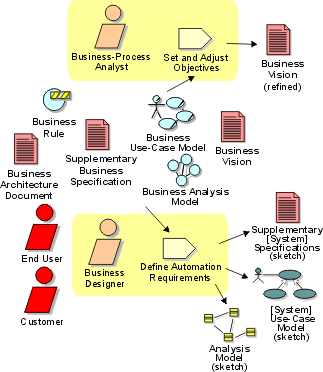Workflow Detail: Explore Process Automation
|
The purpose of this workflow detail is to explore what portions of the business processes can and should be automated. |
|
|
|
Description

The purpose of this workflow detail is to:
- Explore what portions of the business processes can and should be automated.
- Understand how software systems that are to be acquired, developed, or deployed will fit into the organization.
- Derive software requirements for software systems to be acquired, developed, or deployed.
[JAC94] describes three categories of process automation:
- Support for improving lead times of business use cases. This category improves the efficiency of the existing way of working but does not change that way of working.
- Support for reorganizing or sequencing the activities of a business process. This category improves business use cases innovatively and often results in changes to the existing way of working.
- Support for monitoring, controlling, and improving the way of working.
This workflow detail starts with a reconsideration of the objectives defined for the business-modeling effort. Based on the insight and experience that the business-modeling team has gained, objectives and expectations might need to be adjusted. Once the possibilities and constraints for automating and improving the business are agreed upon, the threat of unrealistic expectations or an overambitious project is reduced.
The Business Use Cases are analyzed to determine which offer the greatest potential improvement at the least cost. This is a tradeoff between smaller short-term benefits for relatively less effort and potentially huge long-term benefits at a greater cost. After the business use cases that would benefit the most from automation have been determined, the Business Use-Case Realizations are analyzed. Software system requirements are derived from these realizations, providing input for an initial System Use Case Model, System Analysis Model, and System Supplementary Specifications. For more information on this process, see Guidelines: Going from Business Model to Systems.
It may be necessary to adjust and refine the Business Workers and Business Use-Case Realizations slightly in order to delimit the role of the software system in the business use-case realizations. For example, responsibilities of human business workers can be delegated to automated business workers (software systems). These changes must be reviewed to ensure that the Business Analysis Model remains consistent.
Related Information 
This section provides links to additional information related to this workflow detail.
Timing 
Begins in Inception phase, repeated in later iterations as required/planned.
Optionality 
Recommended for business modeling efforts aimed at improving business processes through automation.
How to Staff

A person acting as a business designer needs to have strong writing skills. Although knowledge of the business is useful, it can be obtained by involving domain experts as reviewers. To perform this workflow detail effectively, you also need people who are familiar with the current set of software systems used in the organization, from both functional and support points of view. If you will be considering how business processes can be automated, people who are knowledgeable about the implications of any new technology under consideration will be necessary (for example, a software architect).
Work Guidelines

The work centers around the business use-case realizations. Discuss automation by considering the time, cost, and quality implications of automating a business worker (or part of a business worker). When only some of the responsibilities of a business worker will be automated, split the business worker into an automated and a non-automated part. Do not consider only efficiency when exploring process automation; there is more strategic advantage in finding the radical new possibilities provided by software support [Business Modeling].
This content developed or partially developed by  Empulsys BV. Empulsys BV.
|

